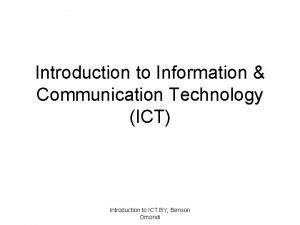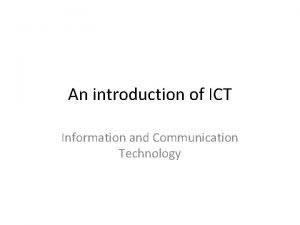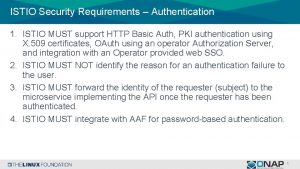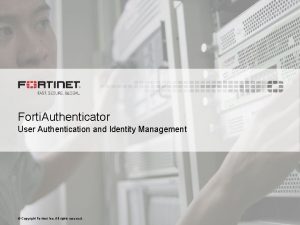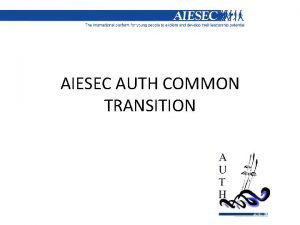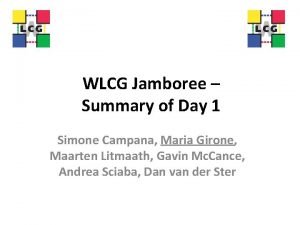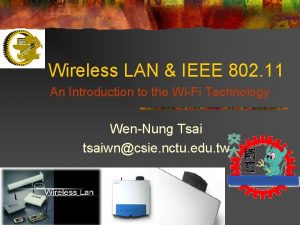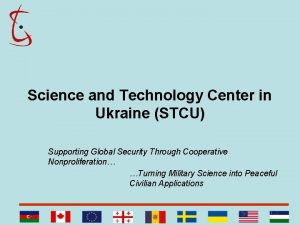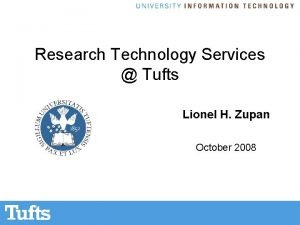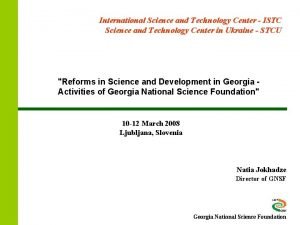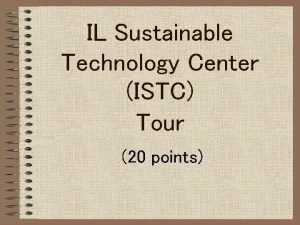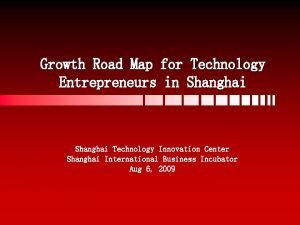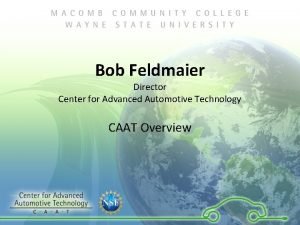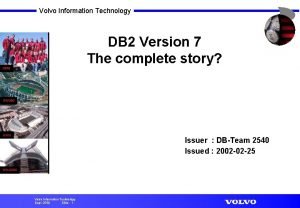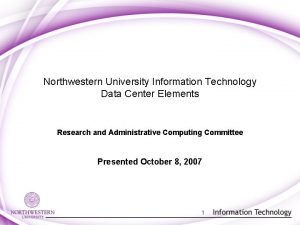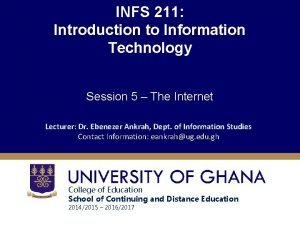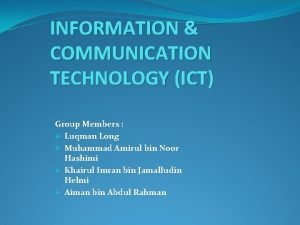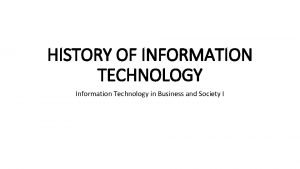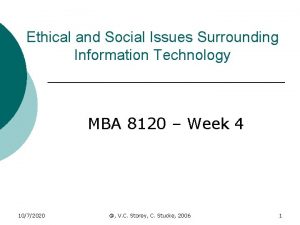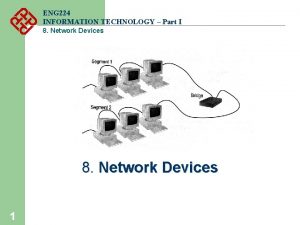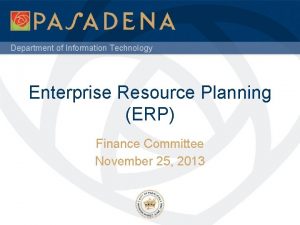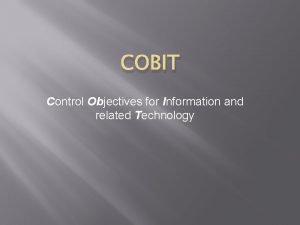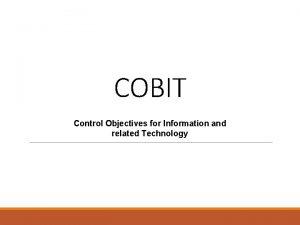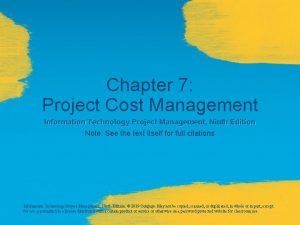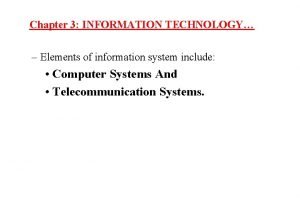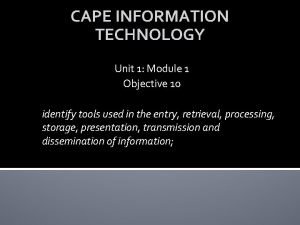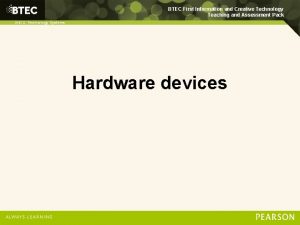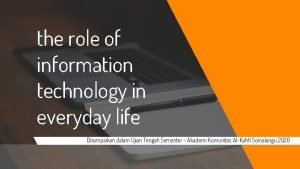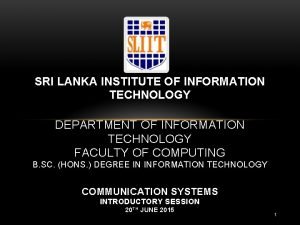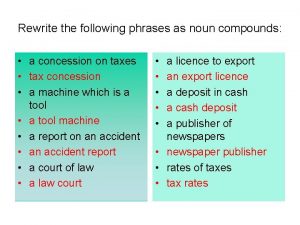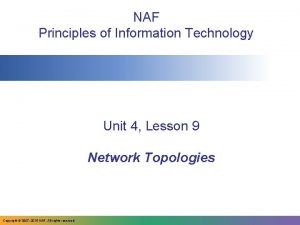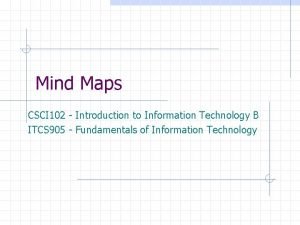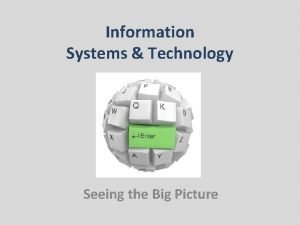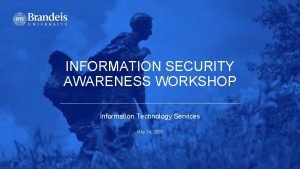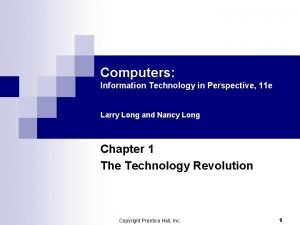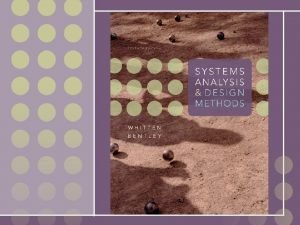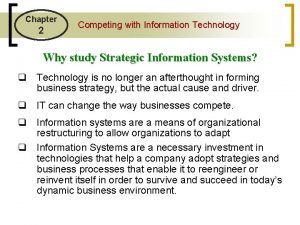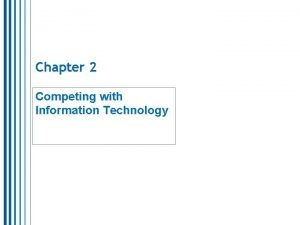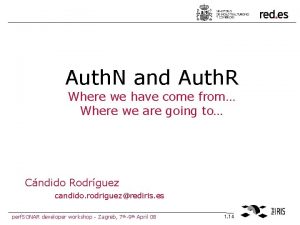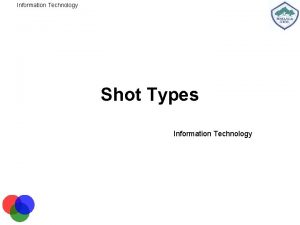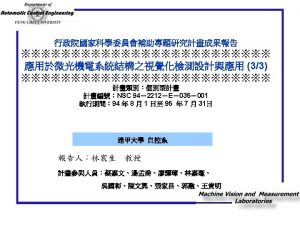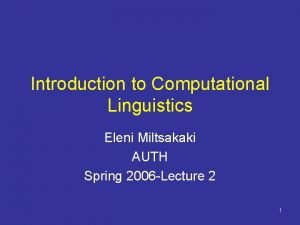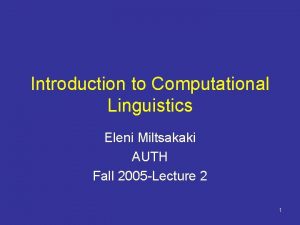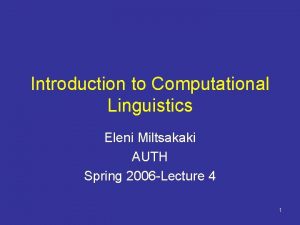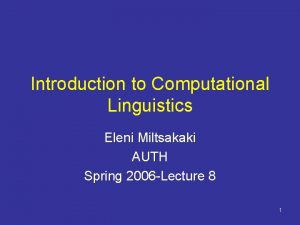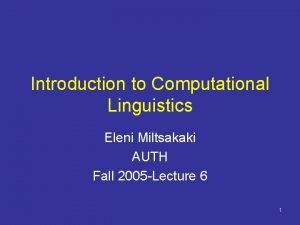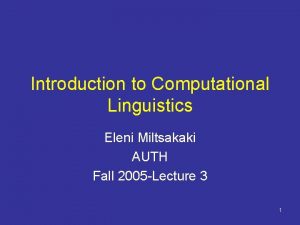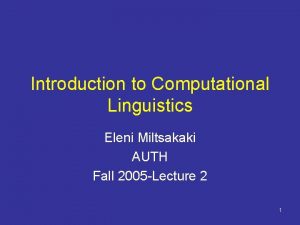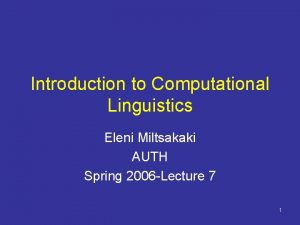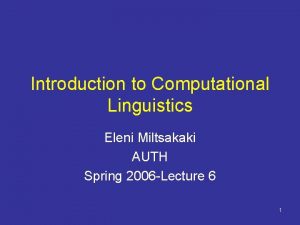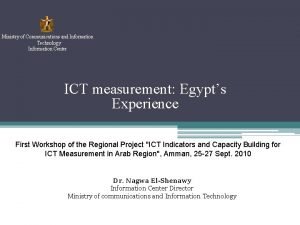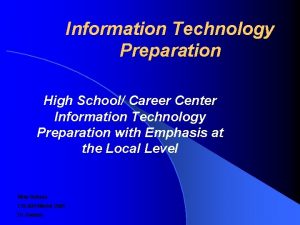it auth AUTH Information Technology Center Introduction to
















































































- Slides: 80

it. auth | AUTH Information Technology Center Introduction to parallel computing concepts and technics ARIS Training (September 2015) | Paschalis Korosoglou (pkoro@it. auth. gr)

it. auth | AUTH Information Technology Center Outline • Parallel programming concepts and approaches • Utilities (Makefiles, git, Compilers, Libraries & Tools) • Libraries for HPC parallel programming – Open. MP – MPI • Hands-on exercises ARIS Training (September 2015)

it. auth | AUTH Information Technology Center Science goes “in-silico” • Exact solutions are not always possible using current theoretical tools and methods – i. e. most problems we have to solve are non-linear • Numerical integration and simulation technics are providing answers to difficult problems • The more complex the problem the more demanding the solution will be. Hence, high end research requires – better hardware – improved software stacks etc ARIS Training (September 2015)

it. auth | AUTH Information Technology Center Methods • • Monte-carlo (Map. Reduce in general) Finite differences, finite volumes (structured grids) Finite elements (unstructured grids) Spectral analysis Dense Linear Algebra Sparse Linear Algebra N-body & particles simulations ARIS Training (September 2015)

it. auth | AUTH Information Technology Center Fields of application • Astrophysics • Biology • Chemistry • Climate • Economy • Engineering • High energy physics • Nanotechnology • Seismology • Sociology and many more… ARIS Training (September 2015)

it. auth | AUTH Information Technology Center As a field expert you will most likely ask the following. . – “Is it possible to increase the problem size? ” – “Is it possible to reduce the time it takes to solve the problem? ” Your friendly computer engineer will likely respond. . – “Ok, look. We have a new machine on the way and we expect it to be available in a couple of months. If you can wait until then we can try out your code and hopefully it will work the way you want it to” – Hardware specs – “Well you can try improving your code. What does profiling tell you? Do you overlap computation with communication? And what about I/O? Is that going to be a bottleneck? ” – Software refactoring – “Have you tried linking it with Intel MKL? ” – Code re-use ARIS Training (September 2015)

it. auth | AUTH Information Technology Center Start off serially and take one step at a time • But don’t get too excited. You are not living in the 90 s any more… “From 2007 to 2011, maximum CPU clock speed (with Turbo Mode enabled) rose from 2. 93 GHz to 3. 9 GHz, an increase of 33%. From 1994 to 1998, CPU clock speeds rose by 300%. ” ARIS Training (September 2015)

it. auth | AUTH Information Technology Center Parallel programming • Parallel programming may overcome the hardware issues but before doing anything parallel make sure that: – Your serial code is already optimal! Questions to ask yourself: • Are you using other people’s computational and I/O libraries? • Have you tested with other compilers and, if yes, have you tried various optimization flags? • What does profiling tell you? ARIS Training (September 2015)

it. auth | AUTH Information Technology Center Overview of Parallel computing • In parallel computing a program spawns several concurrent processes • decrease the runtime needed to solve a problem or • increase the problem size to be solved • The original problem is decomposed into tasks that ideally run independently • Source code development within some parallel programming environment • hardware platform • nature of the problem • performance goals ARIS Training (September 2015)

it. auth | AUTH Information Technology Center Hardware considerations Shared memory Distributed memory ARIS Training (September 2015)

it. auth | AUTH Information Technology Center Hardware considerations Shared memory Distributed memory • Each thread shares the same address space with other threads • Each process (or processor) has unique address space • knowledge of where data is stored is of no concern to the user • Direct access to another processors memory not allowed • Process synchronization is explicit • Process synchronization occurs implicitly • Not scalable ARIS Training (September 2015)

it. auth | AUTH Information Technology Center Parallel programming models Shared memory Distributed memory • Thread based programming approach • Compiler directives (i. e. Open. MP) • Message passing may also be used (think hybrid) • Easier (but trickier sometimes) to implement • Developer uses “Message Passing” in order to sync processes and share data among them • Message passing libraries • MPI being the most common • Difficult to implement ARIS Training (September 2015)

it. auth | AUTH Information Technology Center Nature of the problem • Parallel computing – Embarrassingly parallel (parametric studies) – Multiple processes concurrently (Domain and/or functional decomposition) ARIS Training (September 2015)

it. auth | AUTH Information Technology Center Nature of the problem (examples) • Functional partitioning • Domain decomposition ARIS Training (September 2015)

it. auth | AUTH Information Technology Center Amdahl’s Law Amdahl’s law predicts theoretical maximum speedup when using multiple processors ARIS Training (September 2015)

it. auth | AUTH Information Technology Center Does HPC run only on Linux? Why? • It’s stable, lightweight and well documented • It does the job • It supports as many and even more tools for computing More than 80% of the systems on the Top 500 list run Linux ARIS Training (September 2015)

it. auth | AUTH Information Technology Center Setting the ground • Anything in Courier usually denotes something you type in a terminal window • Lines starting with ‘#’ or ‘$’ signs usually denote commands you will have to issue • The‘<‘, ’>’ marks are used to denote segments you need to change before you type in. – Stuff in italic is usually also stuff you will need to replace ARIS Training (September 2015)

it. auth | AUTH Information Technology Center Hands-on! $ ssh <username>@login. aris. grnet. gr Note: The available editors on ARIS are vi, vim and nano. If you are not comfortable using vi or vim please use nano. ARIS Training (September 2015)

it. auth | AUTH Information Technology Center Command $ ls -la Useful. Listcommands contents of current working directory (the -la Description part is optional for long and all listing) $ mkdir directory Create a new directory (folder) $ cd directory Change the current working directory. Note that cd. . Takes you one folder up. $ pwd Print the current working directory (where – on which path – am I) $ hostname Print the name of the host (where am I logged onto) $ whoami Print my username (who am I) $ who Print a list of everyone logged in right now. $ cat <filename> Prints out the contents of a file in stdout (terminal session) ARIS Training (September 2015)

it. auth | AUTH Information Technology Center Information discovery Command Description $ uname -a Provides information on architecture and kernel version $ lsb_release -a OS name and version (redhat based systems only) $ sinfo Provides a list of available resources, their properties and their current state $ squeue Displays the submitted list of your jobs $ sbatch <job> Sumbits the given job to the ARIS cluster ARIS Training (September 2015)

it. auth | AUTH Information Technology Center Command Description $ git clone <url> Clone a git repository. The whole remote repository (incl. commits and branches is synced locally). One time operation. $ git add <files> Stage files for commit (but don’t commit) within local repository. $ git commit –m “some message” Commit all staged changes to the local repository. The message is recorded along with a unique hash (commit id) $ git push Push my changes (commits) to the remote repository (the one that was cloned in the beginning). $ git pull Pull any changes from the remote repository and merge the remote branch into the current branch if possible. ARIS Training (September 2015)

it. auth | AUTH Information Technology Center The Makefile • Define a set of rules to follow – Used mainly for source code compilation – Helpful during development phase when small changes are made to specific files math. o: math. c math. h gcc –c math. c -o math. o ARIS Training (September 2015)

it. auth | AUTH Information Technology Center The Makefile • Define a set of rules to follow – Used mainly for source code compilation – Helpful during development phase when small changes are made to specific files target dependancies rule math. o: math. c math. h gcc –c math. c -o math. o ARIS Training (September 2015)

it. auth | AUTH Information Technology Center The Makefile • Define a set of rules to follow – Used mainly for source code compilation – Helpful during development phase when small changes are made to specific files target dependancies rule math. o: math. c math. h gcc –c math. c -o math. o or math. o: math. c math. h gcc -c $< -o $a ARIS Training (September 2015)

it. auth | AUTH Information Technology Center Hands-on! $ ssh <username>@login. aris. grnet. gr $w $ pwd $ cd $WORKDIR $ pwd $ git clone https: //github. com/hpc-grnet-gr/aristraining-sep-2015. git $ ls –la $ cd aris-training-sep-2015 ARIS Training (September 2015)

it. auth | AUTH Information Technology Center Hands-on! $. . . $ cd aris-training-sep-2015 $ cd my_first_ARIS_job $ cat simple ARIS Training (September 2015)

it. auth | AUTH Information Technology Center SLURM scripts #!/bin/bash #SBATCH --job-name=simple_job #SBATCH --time=00: 01: 00 #SBATCH --account=sept 2015 #SBATCH --partition=compute # this is a comment sleep 30 /bin/hostname ARIS Training (September 2015)

it. auth | AUTH Information Technology Center Hands-on! $. . . $ cd aris-training-sep-2015 $ cd my_first_ARIS_job $ cat simple. . . $ sbatch simple $ squeue $ ls -lrt ARIS Training (September 2015)

it. auth | AUTH Information Technology Center Job script creator http: //doc. aris. grnet. gr/scripttempla te/ ARIS Training (September 2015)

it. auth | AUTH Information Technology Center Introduction to Open. MP ARIS Training (September 2015) | Paschalis Korosoglou (pkoro@it. auth. gr)

it. auth | AUTH Information Technology Center Overview of Open. MP • • • Shared vs Distributed memory models (recap) Why Open. MP How Open. MP works Basic examples How to execute the executable ARIS Training (September 2015)

it. auth | AUTH Information Technology Center ARIS Training (September 2015)

it. auth | AUTH Information Technology Center Introduction to Open. MP • Extension to C/C++ and Fortran languages – Most compilers support Open. MP • GNU, Intel, PGI, Path. Scale, Open 64 … • Extensively used for writing programs for shared memory architectures over the past decade • Threads communication is implicit and uses variables pointing to shared memory locations; this is in contrast with MPI which uses explicit messages passed among each process ARIS Training (September 2015)

it. auth | AUTH Information Technology Center Threaded parallel programming (open. MP) • open. MP is based on a fork - join model • Master - worker threads Use of directives and pragmas within source code ARIS Training (September 2015)

it. auth | AUTH Information Technology Center Approach towards parallelism • From serial to parallel with Open. MP ARIS Training (September 2015)

it. auth | AUTH Information Technology Center Memory issues • Threads have access to the same address space • Communication is implicit • Programmer needs to define • local data • shared data ARIS Training (September 2015)

it. auth | AUTH Information Technology Center Hello world example Environment variable OMP_NUM_THREADS ARIS Training (September 2015)

it. auth | AUTH Information Technology Center Hello world example ARIS Training (September 2015)

it. auth | AUTH Information Technology Center Common calls Call Description int omp_get_num_threads() Returns the number of threads in the concurrent team int omp_get_thread_num() Returns the id of the thread inside the team int omp_get_num_procs() Returns the number of processors in the machine int omp_get_max_threads() Returns maximum number of threads that will be used in the next parallel region double omp_get_wtime() Returns the number of seconds since a time in the past bool omp_in_parallel() 1 if in parallel region, 0 otherwise ARIS Training (September 2015)

it. auth | AUTH Information Technology Center Common calls example ARIS Training (September 2015)

it. auth | AUTH Information Technology Center Data scoping • For each parallel region the data environment is constructed through a number of clauses – shared (variable is common among threads) – private (variable inside the construct is a new variable) – firstprivate (variable is new but initialized to its original value) – lastprivate (variable’s last value is copied outside construct) – reduction (variable’s value is reduced at the end) ARIS Training (September 2015)

it. auth | AUTH Information Technology Center A few examples x=3 x=2 x=3 or x=2 x=3 Will print anything and then x=1 x=2 x=1 ARIS Training (September 2015)

it. auth | AUTH Information Technology Center Synchronization • Open. MP provides several synchronization mechanisms – – barrier (synchronizes all threads inside the team) master (only the master thread will execute the block) critical (only one thread at a time will execute) atomic (same as critical but for one memory location) ARIS Training (September 2015)

it. auth | AUTH Information Technology Center Synchronization examples foo(3), foo(3) foo(2), foo(3) ARIS Training (September 2015) or foo(1), foo(2)

it. auth | AUTH Information Technology Center Data parallelism • Worksharing constructs – – Threads cooperate in doing some work Thread identifiers are not used explicitly Most common use case is loop worksharing Worksharing constructs may not be nested • DO/for directives are used in order to determine a parallel loop region ARIS Training (September 2015)

it. auth | AUTH Information Technology Center The for loop directive #pragma omp for [clauses] for (iexpr ; test ; incr) • Where clauses may be – private, firstprivate, lastprivate – Reduction – Schedule – Nowait • Loop iterations must be independent • Can be merged with parallel constructs • Default data sharing attribute is shared ARIS Training (September 2015)

it. auth | AUTH Information Technology Center The for loop directive j must be declared private explicitly i is privatized automatically Implicit synchronization point at the end of for loop ARIS Training (September 2015)

it. auth | AUTH Information Technology Center The schedule clause • Schedule clause may be used to determine the distribution of computational work among threads • static, chunk; The loop is equally divided among pieces of size chunk which are evenly distributed among threads in a round robin fashion • dynamic, chunk; The loop is equally divided among pieces of size chunk which are distributed for execution dynamically to threads. If no chunk is specified chunk=1 • guided; similar to dynamic with the variation that chunk size is reduced as threads grab iterations • Configurable globally via OMP_SCHEDULE • i. e. setenv OMP_SCHEDULE "dynamic, 4" ARIS Training (September 2015)

it. auth | AUTH Information Technology Center Adding two vectors ARIS Training (September 2015)

it. auth | AUTH Information Technology Center Reduction clause • Useful in the case one variable’s value is accumulated within a loop • Using the reduction clause – A private copy per thread is created and initialized – At the end of the region the compiler safely updates the shared variable – Operators may be +, *, -, /, &, ^, |, &&, || ARIS Training (September 2015)

it. auth | AUTH Information Technology Center Reduction clause example ARIS Training (September 2015)

it. auth | AUTH Information Technology Center Introduction to MPI ARIS Training (September 2015) | Paschalis Korosoglou (pkoro@it. auth. gr)

it. auth | AUTH Information Technology Center Message Passing Model • A process may be defined as a program counter and an address space • Each process may have multiple threads sharing the same address space • Message Passing is used for communication among processes • synchronization • data movement between address spaces 5 3 ARIS Training (September 2015)

it. auth | AUTH Information Technology Center Message Passing Interface • MPI is a message passing library specification • not a language or compiler specification • no specific implementation • Source code portability • SMPs • clusters • heterogeneous networks ARIS Training (September 2015) 5 4

it. auth | AUTH Information Technology Center Types of communication • Point-to-Point calls • data movement • Collective calls • data movement • reduction operations • Synchronization (barriers) • Initialization, Finalization calls ARIS Training (September 2015) 5 5

it. auth | AUTH Information Technology Center MPI Features • Point-to-point communication • Collective communication • One-sided communication • Communicators • User defined datatypes • Virtual topologies • MPI-I/O 5 6 ARIS Training (September 2015)

it. auth | AUTH Information Technology Center Basic MPI calls • MPI_Init • MPI_Comm_size (get number of processes) • MPI_Comm_rank (gets a rank value assigned to each process) • MPI_Send (cooperative point-to-point call used to send data to receiver) • MPI_Recv (cooperative point-to-point call used to receive data from sender) • MPI_Finalize 5 7 ARIS Training (September 2015)

it. auth | AUTH Information Technology Center Hello World! 5 8 ARIS Training (September 2015)

it. auth | AUTH Information Technology Center Hello World! if ( ierror. ne. MPI_SUCCESS ) then. . . do error handling as desired. . . end if 5 9 ARIS Training (September 2015)

it. auth | AUTH Information Technology Center Starting and exiting the MPI environment • MPI_Init • C style: int MPI_Init(int *argc, char ***argv); • accepts argc and argv variables (main arguments) • F style: MPI_INIT ( IERROR ) • Almost all Fortran MPI library calls have an integer return code • Must be the first MPI function called in a program • MPI_Finalize • C style: int MPI_Finalize(); • F style: MPI_FINALIZE ( IERROR ) 6 0 ARIS Training (September 2015)

it. auth | AUTH Information Technology Center Communicators • All mpi specific communications take place with respect to a communicator • Communicator: A collection of processes and a context • MPI_COMM_WORLD is the predefined communicator of all processes • Processes within a communicator are assigned a unique rank value 6 1 ARIS Training (September 2015)

it. auth | AUTH Information Technology Center A few basic considerations • Q: How many processes are there? A: (N) • (C) MPI_Comm_size( MPI_COMM_WORLD, &size ); • (F) MPI_COMM_SIZE( MPI_COMM_WORLD, size, ierr) • Q: Which one is which? A: [0, (N-1)] • (C) MPI_Comm_rank( MPI_COMM_WORLD, &rank ); • (F) MPI_COMM_RANK( MPI_COMM_WORLD, rank, ierr) • The rank number is between 0 and (size - 1) unique per process 6 2 ARIS Training (September 2015)

it. auth | AUTH Information Technology Center Sending and receiving messages • Questions • • • Where is the data? What type of data? How much data is sent? To whom is the data sent? How does the receiver know which data to collect? 6 3 ARIS Training (September 2015)

it. auth | AUTH Information Technology Center What is contained within a message? • message data • buffer • count • datatype • message envelope • source/destination rank • message tag (tags are used to discriminate among messages) • communicator 6 4 ARIS Training (September 2015)

it. auth | AUTH Information Technology Center MPI Standard (Blocking) Send/Receive • Syntax • MPI_Send(void *buffer, int count, MPI_Datatype, int dest, int tag, MPI_Comm comm); • MPI_Recv(void *buffer, int count, MPI_Datatype, int src, int tag, MPI_Comm comm, MPI_Status status); • Processes are identified using dest/src values and the communicator within the message passing takes place • Tags are used to deal with multiple messages in an orderly manner • MPI_ANY_TAG and MPI_ANY_SOURCE may be used as wildcards on the receiving process ARIS Training (September 2015) 6 5

it. auth | AUTH Information Technology Center MPI Datatypes 6 6 ARIS Training (September 2015)

it. auth | AUTH Information Technology Center Getting information about a message • Information of source and tag is stored in MPI_Status variable • status. MPI_SOURCE • status. MPI_TAG • MPI_Get_count can be used to determine how much data of a particular type has been received • MPI_Get_count( &status, MPI_Datatype, &count); ARIS Training (September 2015)

it. auth | AUTH Information Technology Center A deadlock example (? ) Program Output: from process 1 using tag 158 buf 1[N-1] = 8. 1 from process 0 using tag 157 buf 0[N-1] = 0. 9 double buf 0[N], buf 1[N]; MPI_Status status; int tag_of_message, src_of_message; if( rank == 0 ) { for(int i=0; i<N; i++) buf 0[i] = 0. 1 * (double) i; MPI_Send(buf 0, N, MPI_DOUBLE, 1, 157, MPI_COMM_WORLD); MPI_Recv(buf 1, N, MPI_DOUBLE, 1, 158, MPI_COMM_WORLD, &status); tag_of_message = status. MPI_TAG; src_of_message = status. MPI_SOURCE; cout << "from process " << src_of_message << " using tag " << tag_of_message << " buf 1[N-1] = " << buf 1[N-1] << endl; } else if ( rank == 1 ) { for(int i=0; i<N; i++) buf 1[i] = 0. 9 * (double) i; MPI_Send(buf 1, N, MPI_DOUBLE, 0, 158, MPI_COMM_WORLD); MPI_Recv(buf 0, N, MPI_DOUBLE, 0, 157, MPI_COMM_WORLD, &status); tag_of_message = status. MPI_TAG; src_of_message = status. MPI_SOURCE; cout << "from process " << src_of_message << " using tag " << tag_of_message << " buf 0[N-1] = " << buf 0[N-1] << endl; } ARIS Training (September 2015)

it. auth | AUTH Information Technology Center Blocking communication • MPI_Send does not complete until buffer is empty (available for reuse) • MPI_Recv does not complete until buffer is full (available for use) • MPI uses internal buffers (the envelope) to pack messages, thus short messages do not produce deadlocks • To avoid deadlocks either • reverse the Send/Receive calls on one end or • use the Non-Blocking calls (MPI_Isend) followed by MPI_Wait ARIS Training (September 2015)

it. auth | AUTH Information Technology Center Communication Types • Blocking: If a function performs a blocking operation, then it will not return to the caller until the operation is complete. • Non-Blocking: If a function performs a non-blocking operation, it will return to the caller as soon as the requested function has been initialized. • Using non-blocking communication allows for higher program efficiency if calculations can be performed while communication activity is going on. This is referred to as overlapping computation with communication ARIS Training (September 2015)

it. auth | AUTH Information Technology Center Collective communications • All processes within the specified communicator participate • All collective operations are blocking • All processes must call the collective operation • No message tags are used • Three classes of collective communications • Data movement • Collective computation • Synchronization ARIS Training (September 2015)

it. auth | AUTH Information Technology Center Examples of collective operations ARIS Training (September 2015)

it. auth | AUTH Information Technology Center Synchronization • MPI_Barrier ( comm ) • Execution blocks until all processes in comm call it • Mostly used in highly asynchronous programs 7 4 ARIS Training (September 2015)

it. auth | AUTH Information Technology Center Timing using MPI • MPI_Wtime returns number of seconds since an arbitrary point in the past double mpi_t 0, mpi_t 1; if(rank == 0) { mpi_t 0 = MPI_Wtime(); } sleep(1); MPI_Barrier( MPI_COMM_WORLD ); if(rank == 0) { mpi_t 1 = MPI_Wtime(); printf("# MPI_time = %fn", mpi_t 1 -mpi_t 0); } ARIS Training (September 2015)

it. auth | AUTH Information Technology Center Mixing MPI and Open. MP • Hybrid architectures – Clusters on SMPs – HPC Platforms • IBM Blue. Gene (i. e. Jugene) • IBM P 6 (i. e. Huygens) • Good starting point – Mapping of MPI on nodes (interconnection layer) – Multithreading with Open. MP inside SMPs ARIS Training (September 2015)

it. auth | AUTH Information Technology Center Addition of two vectors (OMP) int main(int argv, char **argv) { int n, i; double *x, *y, *buff; n = atoi(argv[1]); x = (double *)malloc(n*sizeof(double)); y = (double *)malloc(n*sizeof(double)); . . . #pragma omp parallel for private(i) shared (x, y) for (i=0; i<n; i++){ x[i] = x[i] + y[i]; } } ARIS Training (September 2015)

it. auth | AUTH Information Technology Center Addition of two vectors (MPI) #include “mpi. h” int main(int argc, char **argv){ int rnk, sz, n, i; double *x, *y, *buff; n = atoi(argv[1]) MPI_Init(&argc, &argv); MPI_Comm_rank(MPI_COMM_WORLD, &rnk); MPI_Comm_size(MPI_COMM_WORLD, &sz); chunk = n / sz; . . MPI_Scatter(&buff[rnk*chunk], chunk, MPI_DOUBLE, x, chunk, MPI_DOUBLE, 0, MPI_COMM_WORLD); MPI_Scatter(&buff[rnk*chunk], chunk, MPI_DOUBLE, y, chunk, MPI_DOUBLE, 0, MPI_COMM_WORLD); for (i=0; i<chunk; i++) x[i] = x[i] + y[i]; MPI_Gather(x, chunk, MPI_DOUBLE, buff, chunk, MPI_DOUBLE, 0, MPI_COMM_WORLD); MPI_Finalize(); } ARIS Training (September 2015)

it. auth | AUTH Information Technology Center Addition of two vectors (HYBRID) #include “mpi. h” int main(int argc, char **argv){ int rnk, sz, n, I, info; double *x, *y, *buff; n = atoi(argv[1]); MPI_Init_thread(&argc, &argv, MPI_THREAD_FUNNELED, &info); MPI_Comm_size(MPI_COMM_WORLD, &sz); chunk = n / sz; MPI_Scatter(&buff[rnk*chunk], chunk, MPI_DOUBLE, x, chunk, MPI_DOUBLE, 0, MPI_COMM_WORLD); MPI_Scatter(&buff[rnk*chunk], chunk, MPI_DOUBLE, y, chunk, MPI_DOUBLE, 0, MPI_COMM_WORLD); #pragma omp parallel for (i=0; i<chunk; i++) x[i] = x[i] + y[i]; MPI_Gather(x, chunk, MPI_DOUBLE, buff, chunk, MPI_DOUBLE, 0, MPI_COMM_WORLD); MPI_Finalize(); } ARIS Training (September 2015)

it. auth | AUTH Information Technology Center Compile and submit a “mm” job Master process decomposes matrix a and provides slave processes with input. Each slave process caries ns=nm/sz rows of a and the complete b matrix to carry out computations. Results are sent back to master who prints out timing. ARIS Training (September 2015)

it. auth | AUTH Information Technology Center 8 1 ARIS Training (September 2015)
 Information technology introduction
Information technology introduction Introduction to information and communication technology
Introduction to information and communication technology Introduction to ict
Introduction to ict Introduction to information technology: your digital world
Introduction to information technology: your digital world Introduction to information technology: your digital world
Introduction to information technology: your digital world Istio security
Istio security Is muni vejce vejci
Is muni vejce vejci Forti auth
Forti auth Aikido/admin/auth
Aikido/admin/auth Auth aiesec
Auth aiesec Aiesec auth
Aiesec auth Auth portal pvusd
Auth portal pvusd Eurep auth
Eurep auth Jamboree auth
Jamboree auth Auth z
Auth z Auth amikom
Auth amikom Stanford
Stanford Science and technology center in ukraine (stcu)
Science and technology center in ukraine (stcu) Missoula technology development center
Missoula technology development center Lionel zupan
Lionel zupan Deutsche bank technology center russia
Deutsche bank technology center russia China automotive technology & research center
China automotive technology & research center Mid del tech
Mid del tech Carver center for the arts and technology
Carver center for the arts and technology Arcadia valley career technology center
Arcadia valley career technology center Popularization of science
Popularization of science Ge center for additive technology advancement
Ge center for additive technology advancement Illinois sustainable technology center
Illinois sustainable technology center Shanghai technology innovation center
Shanghai technology innovation center Technology collaboration center
Technology collaboration center Center for advanced automotive technology
Center for advanced automotive technology Positive impacts of material technology
Positive impacts of material technology Positive impacts of information technology
Positive impacts of information technology Volvo information technology ab
Volvo information technology ab User acceptance of information technology
User acceptance of information technology Conclusion of information communication technology
Conclusion of information communication technology Media literacy vs information literacy
Media literacy vs information literacy Northwestern university information technology
Northwestern university information technology 5 disadvantages of information technology
5 disadvantages of information technology Positive impacts of information technology
Positive impacts of information technology Information technology history
Information technology history Fluency with information technology
Fluency with information technology Issues surrounding information privacy
Issues surrounding information privacy Bridge in ict
Bridge in ict Erp information technology
Erp information technology Future trend in media and information
Future trend in media and information Control objectives for information and related technology
Control objectives for information and related technology Control objectives for information and related technology
Control objectives for information and related technology Information technology project management 9th edition
Information technology project management 9th edition Definitive estimate range
Definitive estimate range Information technology project management 9th edition ppt
Information technology project management 9th edition ppt Information technology chapter 3
Information technology chapter 3 Auditing information technology
Auditing information technology Global information technology management
Global information technology management Managing information technology resources
Managing information technology resources Cape information technology unit 1 notes
Cape information technology unit 1 notes Btec information and creative technology
Btec information and creative technology Accounting information technology and business solutions
Accounting information technology and business solutions Information technology in everyday life
Information technology in everyday life Flowchart in information technology
Flowchart in information technology Sri lanka institute of information technology colors
Sri lanka institute of information technology colors Make noun compounds out of the following phrases
Make noun compounds out of the following phrases Information technology unit 4
Information technology unit 4 Information technology mind map
Information technology mind map Media and information literacy meme
Media and information literacy meme Information technology head
Information technology head Information technology assessment
Information technology assessment Technology big picture
Technology big picture Information technology workshop
Information technology workshop Hsc multiple choice generator
Hsc multiple choice generator When was the internet invented
When was the internet invented Contoh group technology
Contoh group technology Ethics in information technology fourth edition
Ethics in information technology fourth edition Department of information technology
Department of information technology Ministry of electronics and information technology
Ministry of electronics and information technology Latest electronic and information technology in odisha
Latest electronic and information technology in odisha Information technology in perspective
Information technology in perspective 7 building blocks of information technology
7 building blocks of information technology Competing with information technology
Competing with information technology Competing with information technology
Competing with information technology Chapter 1 information technology the internet and you
Chapter 1 information technology the internet and you

